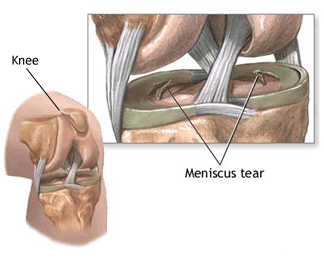Meniscus Tears
The menisci are small, “C”-shaped pieces of cartilage that act as cushions for the knee
joint. Each knee has both a medial (inner, towards the midline of the body) and lateral (outer) meniscus, both sitting on top of the tibia (shin bone).
How does a Meniscus Become Torn?
A meniscus tear usually occurs during movements that forcefully rotate the knee while the knee is bearing weight, which results in the piece of cartilage being torn. If the foot is firmly planted and an athlete quickly twists or rotates the upper leg, a partial or total tear of the meniscus could occur. This is common in sports that require cutting and pivoting such as soccer or football .

Meniscus Tear Symptoms
When a meniscus is injured or torn, mild to severe pain (especially when the knee is straightened) occurs depending on how big the tear is. When a torn meniscus fragment catches between the tibia and femur, severe pain is common. Swelling is also common at the time of injury, but may appear hours later as the joint tissue becomes inflamed. An audible click or pop is frequently heard when the meniscus is injured. The knee may also lock, or feel weak. Smaller meniscus tears may heal over time with no surgery required, although some meniscus injuries benefit from surgical repair.
Diagnosis and Treatment of Meniscus Tears
When a diagnosing a possible meniscus tear, the physician takes a complete history and performs a physical examination of the patient. The extent of the injury is often possible to determine using physical exam techniques that involve manipulating the knee joint in different ways. Using these techniques, the physician looks for pops, clicks, or pain with certain movements that may suggest a meniscus tear.
Treating meniscus tears depends on the extent and location of the tear. Symptoms of smaller tears that do not impede knee function may be resolved with simple short-term treatments. Strengthening the muscles surrounding the knee joint through phyiscal therapy and a short regimen of anti-inflammmatory drugs is typically sufficient to treat such tears.
Larger meniscus tears that reduce the knee’s range of motion or inhibit patient function may need surgery to fully repair. These procedures are typically arthroscopic, using a small camera that is inserted into the joint through a small incision. Surgical instruments are then inserted into a smaller, second incision. The surgeon uses the camera to see the entire joint and then repairs and removes torn pieces of meniscus. The goal of the surgery is to save as much of the original, normal cartilage as possible to prevent further complications. This surgery is minimally invasive and performed in an outpatient setting, meaning most patients are able to go home immediately following surgery.